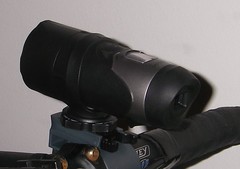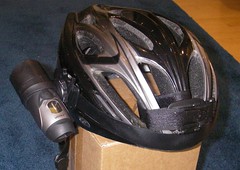Review - Oregon Scientific ATC-2K video camera
 For Christmas, I was given an Oregon Scientific ATC-2K waterproof digital video camera. It is a relatively simple camera, without a view screen and saving all videos onto a memory card. But what appealed to me is that it comes with necessary straps and brackets to attach to most anything, including both a bicycle handle bar and a helmet.
For Christmas, I was given an Oregon Scientific ATC-2K waterproof digital video camera. It is a relatively simple camera, without a view screen and saving all videos onto a memory card. But what appealed to me is that it comes with necessary straps and brackets to attach to most anything, including both a bicycle handle bar and a helmet.
| Summary - Pros + Inexpensive (under $100 at Amazon) + Attaches to most anywhere with provided straps and brackets + waterproof and rugged + Simple to use + Decent battery life + Good for basic action videos which don't need high resolution | Summary - Cons - no vibration stabilization - no software to edit/trim videos - Not high quality video - Not that good for use as a hand held - microphone is basically useless |
Details:
My comparison point for this camera is a Pentax Optio W20
So when I saw the ATC-2K, I was intrigued. Low price and able to attach to most anything, so a couple of hints to my girlfriend and it appeared under the Xmas tree.
Test - Video Comparison
To test the quality of this camera, I turned it and the Pentax Optio W20 on at pretty much the same time, holding both and taping the same thing. Then played back both videos on my computer to compare. Being the ATC-2K is a dedicated video camera, I was hoping it would be as good, if not better, than the Pentax (which is meant to be a still camera first, but with video capabilities).
Oregon Scientific ATC-2K:
Pentax Optio W20:
The result on the whole, the Pentax had slightly better video quality, but both were in the same range. I think it was the image stabilization from the Pentax that made the difference. I have also found times with the ATC-2K that it wasn't getting the full 30 fps, but instead had dropped down to 20-22 fps for some reason.
So you can make the comparison yourself, you can download the video clips in un-edited native form.
Pentax's IMGP3726.MOV file (14 Megabytes)
Oregon Scientific AVI_0103.AVI file (8 Megabytes)
Interesting, I feel this camera should come with some sort of video editing software. This camera is best used (IMHO) as something you start taping before you do something, and stop taping when you are done, and then later edit out the stuff you don't want to see (like the fumbling with the on off buttons). But this requires some software to edit it. Thankfully, I have the software that came with the Pentax, which works just fine.
 Test - Handlebar Mount
Test - Handlebar MountBelow is a video clip I took of a road bike ride as I descended down a hill in the Marin Headlands, with the camera mounted on my handlebars using the handlebar mount provided.
Overall, not that good. The road shudder came straight through. And the microphone only picked up the sounds of the bike vibrating. Perhaps if it was on my mountain bike (with a suspension fork and fat tires to smooth it out), it may be better.
 Test - Helmet Mount
Test - Helmet MountHere is a video clip when I had it attached on my helmet while riding some single track (in Waterdog Park, Belmont, CA). Figured this would be a tougher test than if I used the camera when kayaking, as my head would likely move a lot more on the bike ride.
I think I am happier with the helmet results than with the handlebar results...
One downside is that I installed the camera on the side of the helmet, so I could use the strap that wraps around the helmet. I had to tighten my helmet down a lot to keep the weight of the camera from shifting one side of the helmet down. A tight fitting helmet, or something like a full face helmet, would prevent this.
Test - Battery Life:
To test the battery life - I put a fresh charge on the batteries, installed them, and then turned the camera on and started taping. My goal was to see which would run out first, the 2 gigabyte memory card or the rechargeable AA batteries I used. The card ran out first at about 1 hour, which was what I hoped for. I guess without a view screen, it is very battery efficient.
Interesting, even though I didn't stop and start the video during this test, there were 2 files on the memory card. The first video was 45 minutes, with the remaining 15 minutes on a second file. I guess there is a file size limit or something.
Last thoughts:
I would pay more for better video quality in the camera. Either a higher resolution, a faster saving speed (so it can get the 30 fps claimed), or some sort of shake stabilization would be good improvements and worth paying some more for. But for an inexpensive camera that is small, waterproof, and can be mounted most anywhere, this is a great little camera.
Definitely get an SD card to go with it (probably best to just spring right for the 2 gig card), as the built in memory is only large enough for a few minutes of video.
Labels: Reviews


12 Comments:
Any trouble with it in the cold? Mine wants to shut off at 55 Deg..havent tried it in warmer temps yet...it's mounted to a motorcycle.
No troubles yet, but living in Northern California, I may not have much opportunity. I am sure that at least one of the videos I took was from temps in the 50s, with no noticeable problems.
I do seem to remember seeing that they have a cover which you can buy for when you are using the camera in cold weather, so I guess there is an issue.
I have had troubles with the Pentax Option in cold (below freezing), mostly related to the rechargeable batteries I use not working.
One other minor nit - the file name system. Seems like every time I remove the files from the memory card and then take new video, it restarts with the file name AVI0001.AVI, where I would prefer that it remembers the file names from before, so I don't risk overwriting files when I copy from he card to the computer.
Ok, I have hit some issues with the cold. I had it on the handlebar mount on a day in the 50s, and it did shut itself down (actually, the problem is that it would not power up) after a while.
On prior rides, I stored it in a pocket and only stuck it on my helmet when I was going to use, and it did not show this issue. I Think the pocket insulated the camera some.
Interesting, on this time where it was on my handlebar and shut down, I took the batteries out and warmed them in my hands for a few minutes, and it then worked. So it isn't clear if this issue is with the camera, or my Energizer NiMH rechargeable batteries.
Another update:
I broke the mount by twisting it. Contacted manufacturer by email, and they have a replacement part coming out now charge. Nice!
I used it last night in a pool session while working on my Eskimo roll. It didn't like the low light above the water, but did fine with the pool lighting below the water.
http://www.youtube.com/watch?v=aMyRUV4kpRk
I just got one and when mounting it on a helmet (for kayaking), how do you mount it without the picture being sideways.
Thanks,
Seth
The camera body spins within the bracket that holds it together. The bracket that clips to the helmet mount has a ring on it, and that ring is not actually attached to the camera.
That said, be careful about how you spin it. I did break the bracket once when trying to spin it. It broke between the ring and the clip that goes into the mounts. Hold the ring and the camera, and you shouldn't have this issue.
Thumbs up to Oregon Scientific. I emailed about the breakage, expecting to pay a few bucks to get a replacement part, and they sent one for free (I didn't even pay shipping).
I've also done a review of the GoPro Hero3, a waterproof (to 30+ feet) digital camera.
http://peter-singlespeed.blogspot.com/2008/04/review-gopro-hero-3-camera.html
There is now an ATC-3K out. From my first look at the specs, it seems like the biggest change is that it now accepts a 4 gigabyte card.
Latest version is the ATC-9K. They have added a small display screen starting with the 4K version. Most exciting change for the 9K is that it has a remote control. This allows you to install it further away and control it (where the prior models had to be within reach).
This camera is very handy where ever you could with a straps like that you could easily bring it during your travel and outdoor activities. The only problem is it will not produce a high quality video.
I wrote a review on the ATC-9K which was published in the Fall 2011 issue of California Kayaker Magazine. The magazine can be read online for free at http://www.calkayakermag.com/magazine.html.
I have seen these 2K on sale for remarkable low prices - under $40.
Post a Comment
<< Home